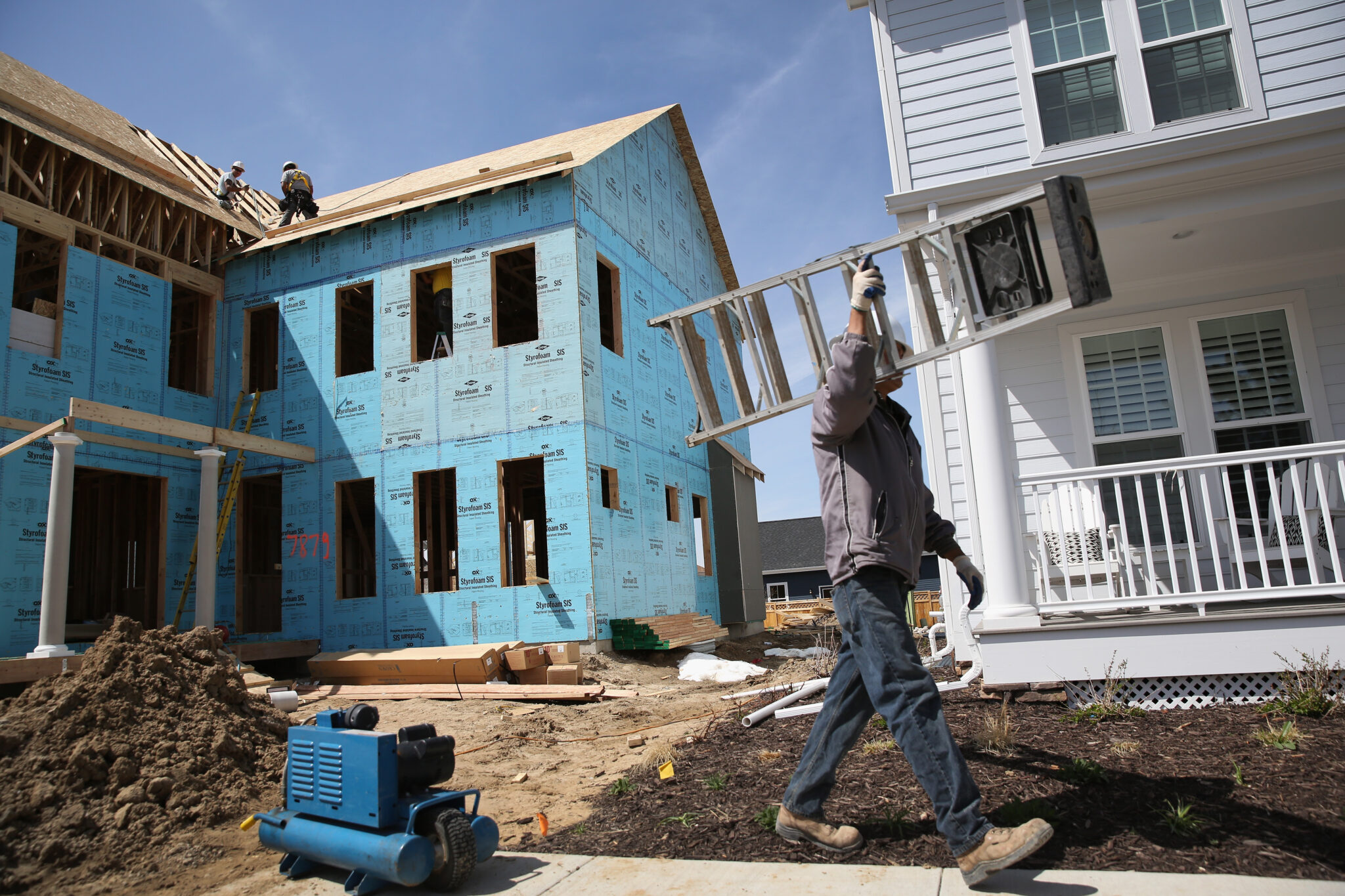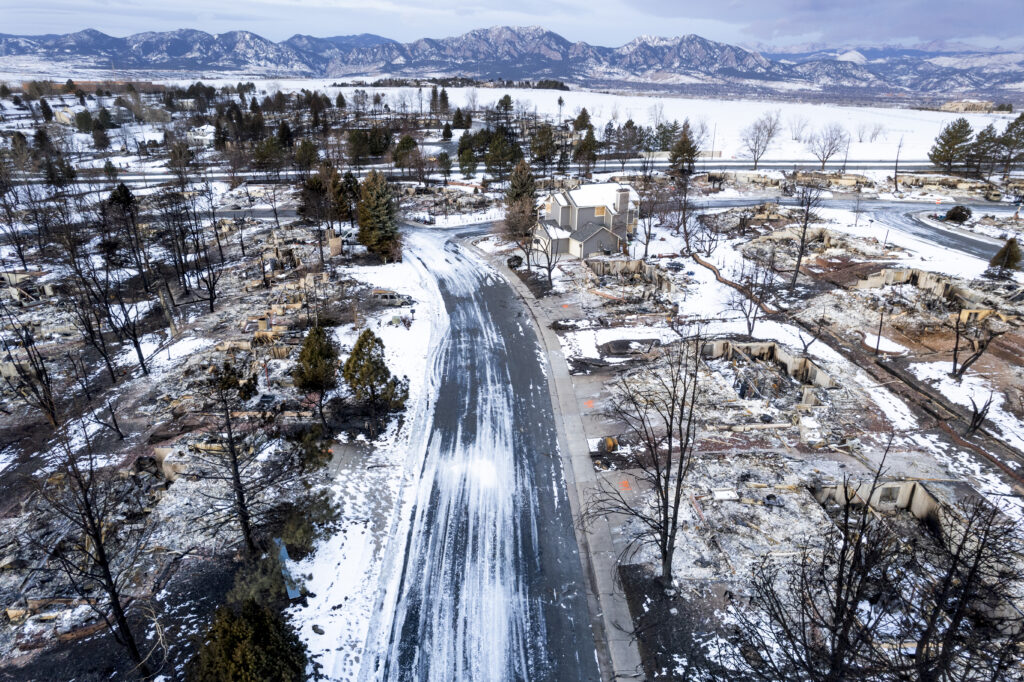 Construction workers work on a housing development on May 3, 2013 in Denver, Colorado. Credit: John Moore/Getty Images
Construction workers work on a housing development on May 3, 2013 in Denver, Colorado. Credit: John Moore/Getty ImagesNow, the state is seeking to address the issues of sustainable land use, affordable housing, and fossil fuel emissions in one fell swoop. A new measure introduced in the state assembly by Gov. Jared Polis and Democratic lawmakers aims to rewrite zoning rules, reduce auto emissions by building more walkable and dense cities, conserve water and electricity, and rein in the sprawl that has left suburban-style homes vulnerable to wildfires.
Colorado joins a growing number of Mountain West states that are reevaluating zoning and land-use policies as the region continues to see steady growth, primarily in suburban areas. The state bill bars municipalities from limiting the construction of duplexes, triplexes and add-on housing units and promotes more transit-oriented and mixed-use areas. As in other states, the goal is not just to remold housing policy but equip communities to cope with climate change.
“Housing policy is climate policy,” Polis said in his State of the State speech in January. “Housing policy is economic policy. Housing policy is transportation policy. Housing policy is water policy. Housing policy is public health and equity policy. It impacts every part of our lives, which is why it’s so critical that we get this right.”
In some cases, the states’ density initiatives have a bipartisan component. Montana recently introduced similar legislation based on recommendations from a housing task force created by Gov. Greg Gianforte, a Republican. In Arizona, a bill that likewise sought to limit cities’ ability to restrict multifamily housing was proposed by a Republican lawmaker but failed to pass in the state Senate.
Colorado’s bill has developed a coalition of support ranging from local environmental groups to housing alliances to the Denver Metro Chamber of Commerce. But some towns object to the bill on the ground that it would override local municipalities in deciding how they grow and what their communities will look like.
“It is a breathtaking power grab,” Kevin Bommer, executive director of the Colorado Municipal League, said in a statement. “Although the bill is being sold as a ‘menu of options’ with ‘flexibility’ to create affordability, it mainly benefits developer interests to the detriment to the quality of life and access to local elected officials expected by Coloradans and with no guarantees that anything built will be ‘affordable.’’’
Factoring Housing Density Into Conservation
Colorado is around 170,000 homes short of a stable housing market. After the economic recession of 2007 to 2009, housing production declined nearly 40 percent while the state’s population continued to grow, though at slower rates than before. With the arrival of the Covid-19 pandemic, a fresh influx of new residents led to escalating rents and home prices. In Denver, for example, the median home price in 2019 was $410,000, according to the Colorado Association of Realtors. As of this February, it was $580,000.
The state bill would address the housing shortfall largely through zoning reform, like legalizing duplex and triplex style homes in single-family neighborhoods and imposing minimum density levels for multifamily housing in areas near mass transit, like Denver’s light rail stations.
The legislation would task the Colorado Department of Local Affairs with conducting an assessment to determine how many homes are needed across the state for residents at different income levels. That would lead to specific plans for municipalities that communities would consider and then resubmit to the department, detailing how they would meet the minimum density and environmental standards. The bill would assign varying criteria to different categories of communities, depending on their size, population and urban or nonurban characteristics.
From the start, the bill was drafted with a focus on how development will affect climate change, said Will Toor, director of the Colorado Energy Office. In addition to oil and gas development, the state’s biggest emitters of greenhouse gases are transportation, electricity generation and fuel use in homes and businesses, he noted, ”most of which are very much impacted by land use and housing decisions.”
Developing vacant or vastly underused parcels of land in cities can help lead to denser and more walkable communities, resulting in lower fuel emissions, state officials and urban planning experts say, and multifamily housing is more energy- and water-efficient than single-owner dwellings. Denser communities typically result in greater use of public transportation rather than cars, reducing emissions further. The bill also prohibits mandates for parking areas tied to the denser housing options, which drive up the cost of development and lead to more driving.
“All roads lead back to land use,” said Matt Frommer, a senior transportation associate at the Southwest Energy Efficiency Project, or SWEEP, which operates in six states and supports the Colorado bill.
Andrew Rumbach, a senior fellow at the Urban Institute, a nonprofit research organization, noted that Western cities like Denver, Phoenix, Las Vegas and Los Angeles developed after the car became central to American society. That meant that urban planning revolved around the automobile, resulting in more roads and highways and a mantra of sprawl, along with the bigger homes and yards associated with the suburbs. Those incentives have generally made it difficult to justify denser development.
Rumbach, who studies the relationship between urban development, natural hazards and climate risks, views the issues of providing more affordable housing and building more sustainable communities as inseparable. Yet urban planning is “a delicate process with a lot of interests,” he notes wryly, and nothing like the video game “SimCity.”
Finally Reckoning With Untrammeled Growth
While some view it as contrary to the region’s history, Rumbach argues that density offers a promising solution for sustainability. “In a place like Colorado or the Mountain West, where we have lots of natural hazards, fires and floods, land is a huge asset,” he said. “So when we can use our land more efficiently by putting more housing on a piece of land or building more densely around transit, that allows us to have less uses in those hazardous areas, which in my view, is the formula for actually creating more resilient places.”
Climate change is exacerbating those hazards. About half of Colorado’s residents live in the “wildland-urban interface,” areas of development built close to the wilderness. From 2012 to 2017, that population grew by 50 percent, according to the Colorado State Forest Service.

In this aerial view, burned homes sit in a neighborhood decimated by the Marshall Fire on Jan. 4, 2022 in Louisville, Colorado. Credit: Michael Ciaglo/Getty Images
The projected growth of the Denver metropolitan area has increased 86 percent over the last 25 years, from 700 to 1,308 square miles, a major factor in the construction of homes in the interface areas, SWEEP says, citing estimates from the Denver Regional Council of Governments. And the Boulder area experienced some of the consequences of building near wildlands in 2021, when the Marshall Fire burned some 6,200 acres, destroying at least 1,084 homes and seven commercial structures.
Like the other six states that rely on supplies from the Colorado River, Colorado is also facing a future of dwindling water. Snowfall this winter helped alleviate some of the problems along the river basin, where over 20 years of drought had resulted in cutbacks in water allotments and tense negotiations among the states, but it won’t solve the long-term problem of scarcity.
Denser developments result in less consumption per household. According to the governor’s office, detached and multifamily housing use anywhere from 22 to 86 percent less water than traditional single-family homes. Under the housing needs plan outlined in the bill, cities and towns would have to meet water conservation requirements and conduct audits of water losses due to leakage, storage overflow, meter malfunctions and other factors.
The devastating droughts and wildfires of recent years are meanwhile forcing Western communities and state governments to reckon with the growth patterns of the past half-century, Rumbach said. He also points out that the minimum requirements proposed in the Colorado bill parallel laws approved elsewhere in the United States.
“Bottom line for me, it says, we can’t grow the population as much as we’re expected to grow and not change the way we’re building,” he said. “Otherwise we’re gonna have suburbs that literally cover the entire state. It’s just not sustainable.
“It’s not good for the environment. It’s not good for disasters. It’s not good for the climate. And so we have to change the way we’re doing things, and this is an interesting attempt to do that.”